About
The first question people tend to have when they hear about the Mummers Museum is "what is a mummer?" Imagine a roving group of drunken masked revelers, demanding food, drink, and a singing match: these are mummers.
The term "mummer" meaning a "disguised person" dates back to medieval times (and probably before; most mummery involves a mix of Christian and pagan traditions that go back to pre-Roman times) and references costumed performers of some kind, though it is unclear exactly what kind of performances mummers gave during these times. Connected with a type of folk play, the common aspect of mummery was the use of masks and elaborate disguises as well as generally rowdy performances. These "mummer plays" and associated customs spread throughout Europe gaining a slightly different tradition and meaning in each area.
Among the many mummer traditions, there were feast mummers who provided entertainment and performed acrobatics at feasts; Newfoundland Mummers, drunken men who dressed up in extravagant drag and demanded booze; the Marshfield Mummers who paraded through town to the sound of a bell to receive donations of whiskey; Aristocratic mummery, which was a sort of English precursor to Masquerade balls; and most entertainingly, a kind of competitive Christmas carol mummery, known as "Social Mummers." These masked groups would sing to a lord, or aristocrat, who would then be required to match them verse for verse. If he failed to do so he would have to invite the masked mummers in and provide food and drink. As one can imagine, this social mummery became rather aggressive over time, with roving groups of drunken masked men performing lewd actions towards the lords who did not comply and demanding food and more drink. Henry the Eighth even banned mummery for a while, and during this time the French masquerade ball took over from the English mummery, at least in aristocratic circles. Later mummery was allowed again in Europe, though in 1861 in Newfoundland mummery was officially banned, after a man in St. John’s was murdered, allegedly by a group either disguised as or actual mummers. The law stands, and Newfoundlanders continue to break it yearly as they perform Christmas mummery traditions.
In the late 1600s settlers from all over Europe, particularly from Sweden, began to settle in Philadelphia, and they brought with them their traditions of mummery. One of the traditions of the Swedes, almost all of whom carried firearms with them, was to "shoot in" the New Year, something we still associate with the holiday.
Known as the New Year’s Shooters and Mummers Association, the group would travel around during Christmas time, sing, and be rewarded with food and drink. Mummery was essentially the drunker, rowdier, firearm-carrying, masked, and pagan ritual-infused precursor to Christmas carolers. It would be the Victorians (particularly Dickens and Washington Irving) who would transform the raucous mummers into the respectful Carolers we think of today, but not in Philadelphia. A familiar Philadelphia mummer chant went: Here we stand before your door, as we stood the year before; Give us whiskey; give us gin, open the door and let us in. Or give us something nice and hot like a steaming hot bowl of pepper pot.
Generally, they were rewarded. In 1839, a witness wrote of men "disguised as clowns, shouting at the top of their voices and shooting guns." By the 1870s mummery was still in full swing having become based around two groups: the Comic Clubs and the Fancy Dress clubs. According to a local report in 1881 "parties of paraders" made the street "almost like a masked Ball." By 1901it had become a massive event and the city began officially supporting the parade.
Today mummers, and the Mummers Parade, are less about roving groups of revelers, and it is a parade event on par with Mardi Gras (which originates from a totally different historical tradition) with over 10,000 marchers and clubs including the Wench Brigade (female mummers), comic, fancy, fancy brigade, and string band each with a different tradition of dress and performance. Unlike Mardi Gras, there are no brass instruments in the Mummers Parade, only strings, and percussion. Many mummers are working-class Philadelphians, but that doesn't stop them from dressing in drag, extravagant sequined body suits, or other outfits that would generally put Cher and Madonna to shame. Brigades spend lavishly on costumes and props- one brigade estimates that expenses for a single show can be up to $100,000.
The Mummers Museum features displays, costumes, and events from different brigades and different eras, showing the rich and vibrant history of the event. It's the only mummer museum in the world, a place to celebrate these extravagant costumes and the history and traditions of the mummers themselves. It's a rare chance to see what a plumber looks like when he is dressed up as a giant saxophone-playing sparkling strutting seahorse.
Related Tags
Community Contributors
Added By
Edited By
Published
December 19, 2009


































